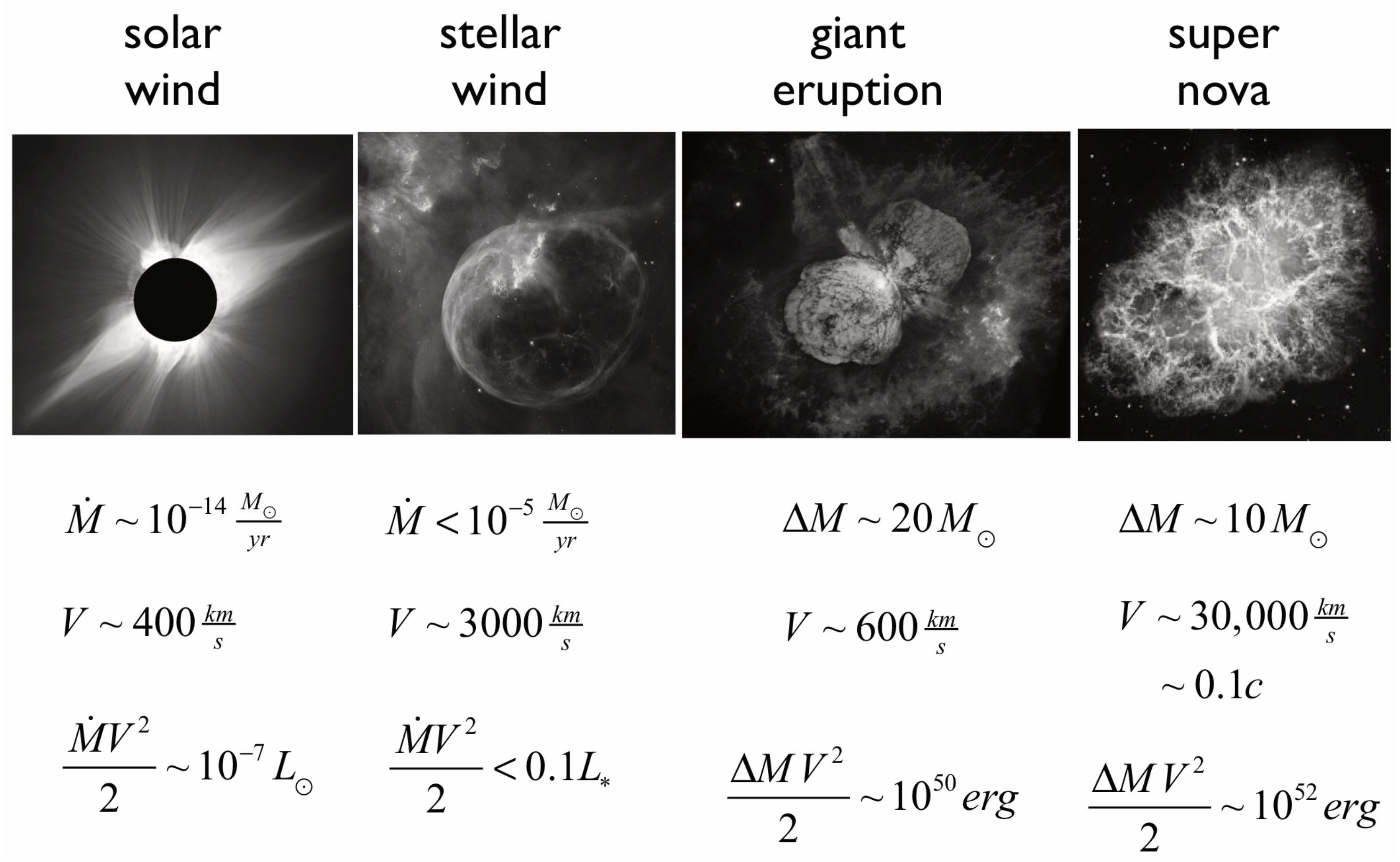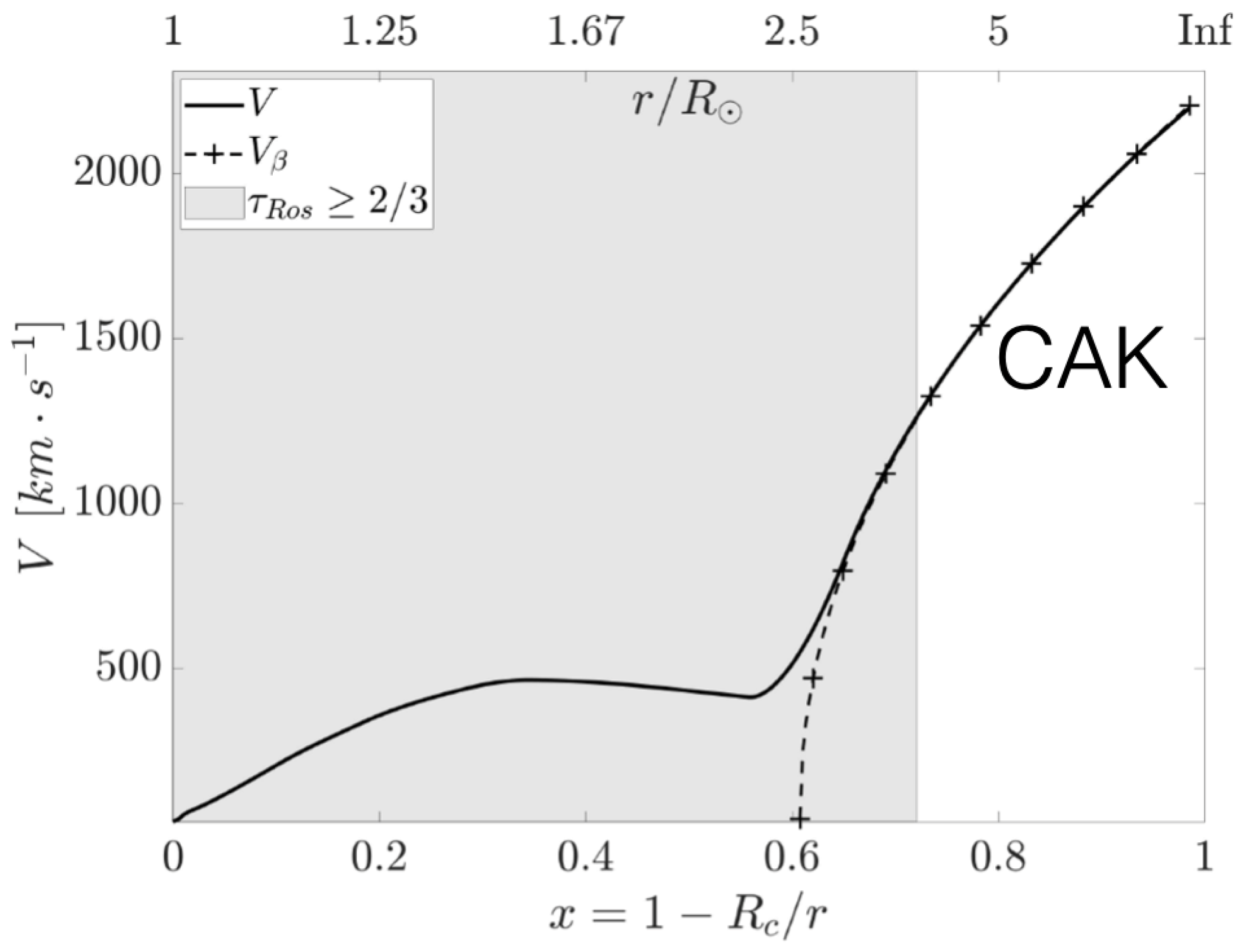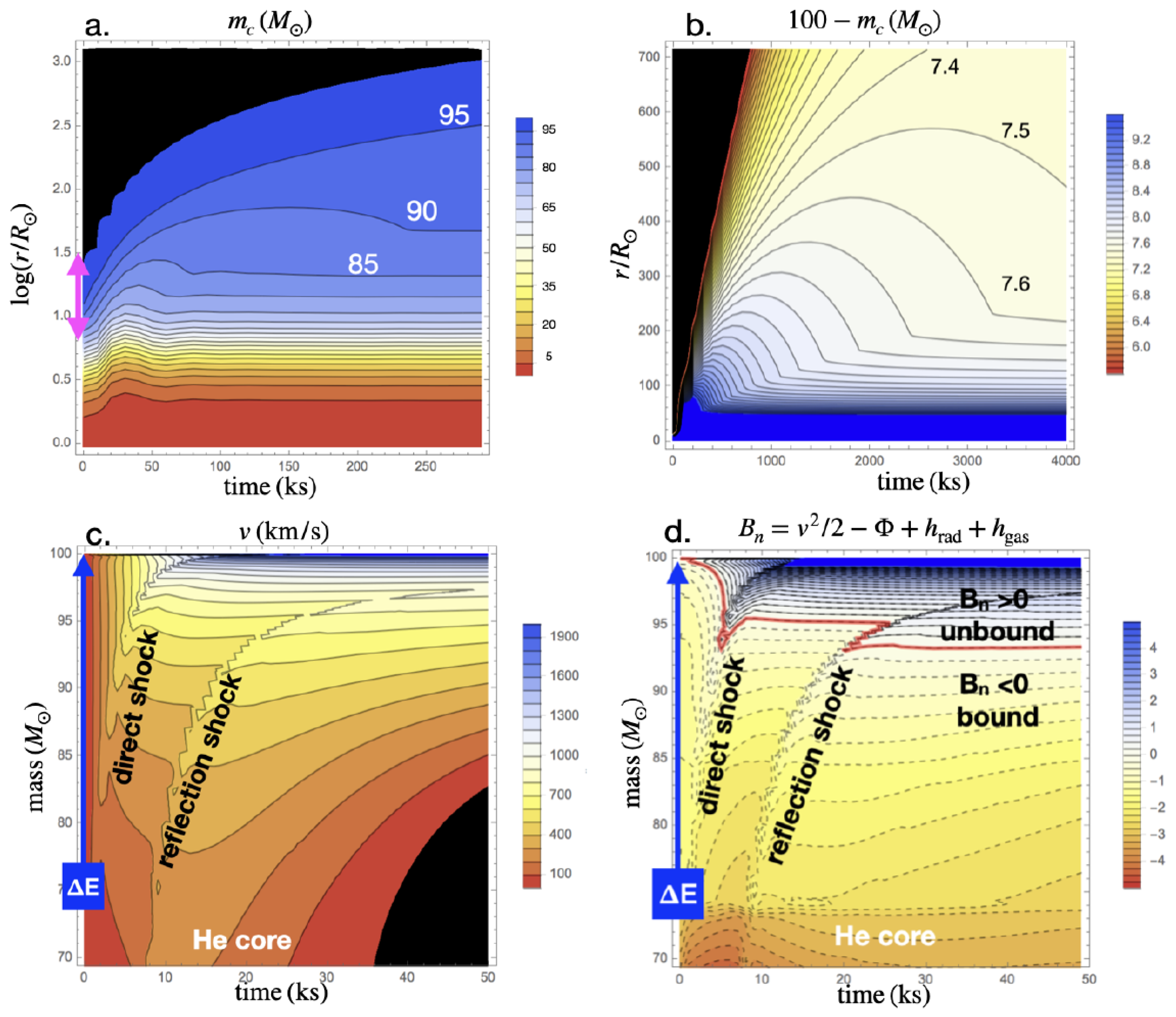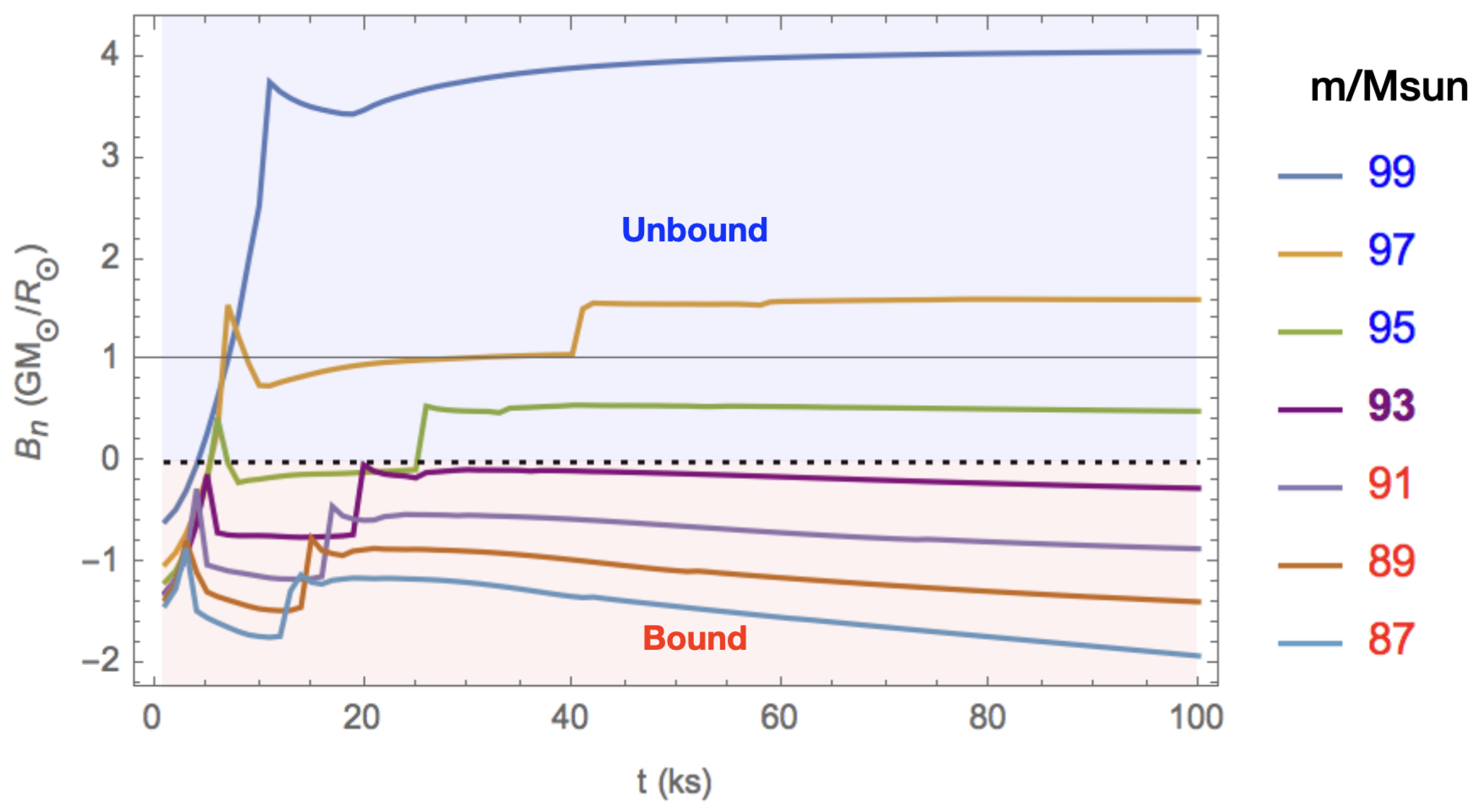Wind and Eruptive Mass Loss near the Eddington Limit
Abstract
1. Introduction
2. Basic Stellar Wind Theory
2.1. Polytropic Winds
2.2. Flux-Driven Scalings
2.3. Line-Driven Scalings
2.4. Continuum Initiation of WR Winds
2.5. Super-Eddington Continuum-Driven Winds
3. Eruptive Mass Loss
3.1. Energy Requirement for eLBV Mass Ejection
3.2. Merger Model for Carinae
4. Concluding Summary
- Radiation-driven winds from hot, luminous, massive stars, with spectral-type OB and WR, can have mass loss rates up to billion times the gas-pressure-driven solar wind.
- Although often characterized as radiation-pressure-driven, their driving is more accurately described by the interaction of the star’s radiative flux with opacity, set by bound–bound line transitions of minor ions, as originally developed by CAK [3].
- The stronger mass loss of WR stars may result from an initiation by the iron opacity bump, which can be treated as a continuum process. As this bump fades, the line desaturation in the expanding wind allows for transition to standard CAK line-driving that propels the outer wind.
- Both OB and WR winds are energetically inefficient, characterized by a "photon-tiring" fraction .
- Winds driven fully by continuum opacity can approach the fundamental tiring limit . For , such winds are sufficiently optically thick for radiation advection to exceed the diffusive flux, which leads to a true radiation-pressure-driven flow that can be characterized in terms of the Bernoulli solution with polytropic index .
- Sudden energy addition into the outer stellar envelope can induce a positive Bernouil energy in the outer layers, causing them to be unbound, with a similarity form for velocity, and a “exponential” similarity form for density. This represents an underlying connection to the above Bernoulli solution for steady, continuum-driven winds.
- The giant eruption in the famous eLBV Carinae may have been induced by the merger of two stars within a dynamically unstable triple system. The rapid rotation and high luminosity of the merger star leads to a super-Eddington wind that is strongest over the poles, which can then sculpt the mass ejection into a bipolar form, seen as the Homunculus nebula.
Funding
Data Availability Statement
Acknowledgments
Conflicts of Interest
| 1 | Throughout this paper, “envelope” refers to the region between the energy-generating stellar core and the optically thin stellar photosphere. |
References
- Davidson, K. Radiation-Driven Stellar Eruptions. Galaxies 2020, 8, 10. [Google Scholar] [CrossRef]
- Weis, K.; Bomans, D. Luminous blue variables. Galaxies 2020, 8, 20. [Google Scholar] [CrossRef]
- Castor, J.I.; Abbott, D.C.; Klein, R.I. Radiation-driven winds in Of stars. Astrophys. J. 1975, 195, 157–174. [Google Scholar] [CrossRef]
- Gayley, K.G. An improved line-strength parameterization in hot-star winds. Astrophys. J. 1995, 454, 410–419. [Google Scholar] [CrossRef]
- Grassitelli, L.; Langer, N.; Grin, N.J.; Mackey, J.; Bestenlehner, J.M.; Graefener, G. Subsonic structure and optically thick winds from Wolf–Rayet stars. Astron. Astrophys. 2018, 614, A86. [Google Scholar] [CrossRef]
- Petrovic, J.; Pols, O.; Langer, N. Are luminous and metal-rich Wolf-Rayet stars inflated? Astron. Astrophys. 2006, 450, 219–225. [Google Scholar] [CrossRef]
- Poniatowski, L.G.; Sundqvist, J.O.; Kee, N.D.; Owocki, S.P.; Marchant, P.; Decin, L.; de Koter, A.; Mahy, L.; Sana, H. Dynamically inflated wind models of classical Wolf-Rayet stars. Astron. Astrophys. 2021, 647, A151. [Google Scholar] [CrossRef]
- Debnath, D.; Sundqvist, J.O.; Moens, N.; Van der Sijpt, C.; Verhamme, O.; Poniatowski, L.G. 2D unified atmosphere and wind simulations of O-type stars. Astron. Astrophys. 2024, 684, A177. [Google Scholar] [CrossRef]
- Fuller, J.; Ro, S. Pre-supernova outbursts via wave heating in massive stars—II. Hydrogen-poor stars. Mon. Not. R. Astron. Soc. 2018, 476, 1853–1868. [Google Scholar] [CrossRef]
- Owocki, S.P.; Townsend, R.; Quataert, E. Super-Eddington stellar winds: Unifying radiative-enthalpy versus flux-driven models. Mon. Not. R. Astron. Soc. 2017, 472, 3749–3760. [Google Scholar] [CrossRef]
- Owocki, S.P.; Hirai, R.; Podsiadlowski, P.; Schneider, F.R. Hydrodynamical simulations and similarity relations for eruptive mass-loss from massive stars. Mon. Not. R. Astron. Soc. 2019, 485, 988–1000. [Google Scholar] [CrossRef]
- Toledano, O.; Koenigsberger, G.; Moreno, E. On the Relevance of Tidal Interactions in HD 5980. In Massive Stars in Interactive Binaries; ASPC: San Francisco, CA, USA, 2007; Volume 367, p. 437. [Google Scholar]
- Koenigsberger, G.; Moreno, E. The extraordinary LBV/WR system HD 5980. arXiv 2008, arXiv:0705.1938. [Google Scholar]
- Hirai, R.; Podsiadlowski, P.; Owocki, S.P.; Schneider, F.R.; Smith, N. Simulating the formation of η Carinae’s surrounding nebula through unstable triple evolution and stellar merger-induced eruption. Mon. Not. R. Astron. Soc. 2021, 503, 4276–4296. [Google Scholar] [CrossRef]







Disclaimer/Publisher’s Note: The statements, opinions and data contained in all publications are solely those of the individual author(s) and contributor(s) and not of MDPI and/or the editor(s). MDPI and/or the editor(s) disclaim responsibility for any injury to people or property resulting from any ideas, methods, instructions or products referred to in the content. |
© 2025 by the author. Licensee MDPI, Basel, Switzerland. This article is an open access article distributed under the terms and conditions of the Creative Commons Attribution (CC BY) license (https://creativecommons.org/licenses/by/4.0/).
Share and Cite
Owocki, S. Wind and Eruptive Mass Loss near the Eddington Limit. Galaxies 2025, 13, 91. https://doi.org/10.3390/galaxies13040091
Owocki S. Wind and Eruptive Mass Loss near the Eddington Limit. Galaxies. 2025; 13(4):91. https://doi.org/10.3390/galaxies13040091
Chicago/Turabian StyleOwocki, Stan. 2025. "Wind and Eruptive Mass Loss near the Eddington Limit" Galaxies 13, no. 4: 91. https://doi.org/10.3390/galaxies13040091
APA StyleOwocki, S. (2025). Wind and Eruptive Mass Loss near the Eddington Limit. Galaxies, 13(4), 91. https://doi.org/10.3390/galaxies13040091






